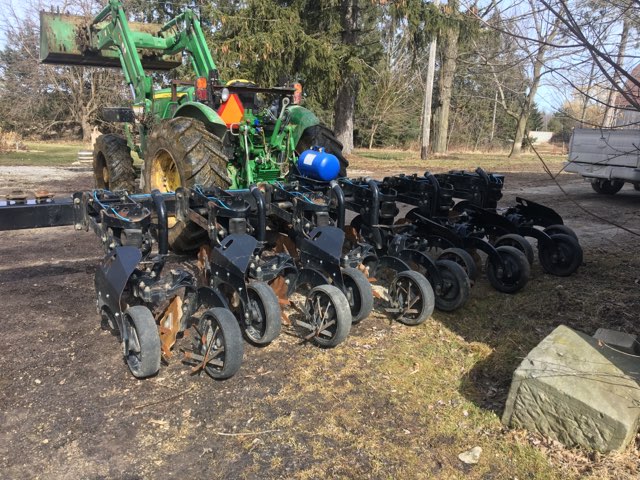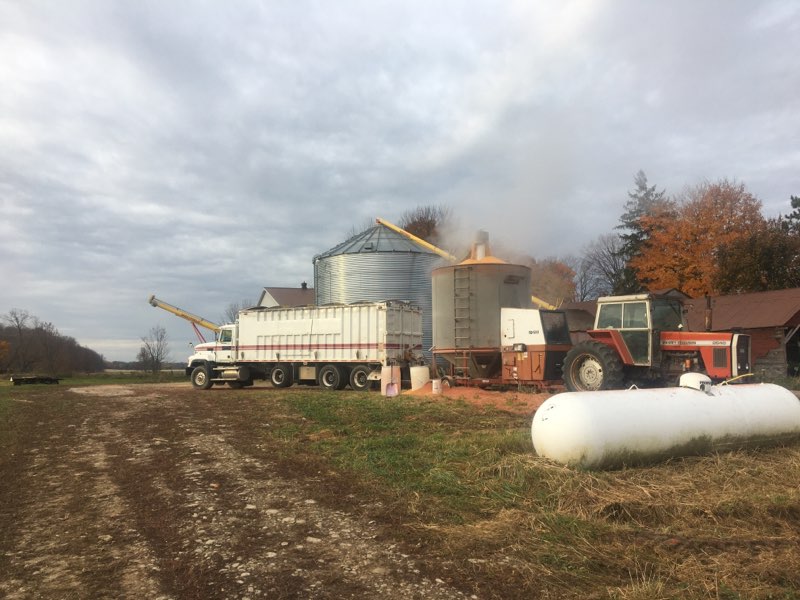Ken and Rosemary Mitchell farm in Annan ON. Ken has been actively involved in the Grey County Soil and Crop Improvement Association for many years, serving as the county’s treasurer. They grow 700 acres of cash crops and 500 acres of hay and pasture and also have 150 acres of managed woodlot which Ken says he likes because he doesn’t have to fertilize it and the better parts produce logs every 10-15 years. In addition to the crop land, they also have a beef herd of 120 cows.
The Mitchells were highlighted in a member spotlight article in 2009, but we decided to re-visit their operation in this issue and find out what they have been working on in the interim. When reading the original member spotlight article, it becomes immediately apparent that the Mitchells are progressive, innovative and invested in good land stewardship. I hope you’ll take the time to re-visit that article (included online in this month’s e-version of the bulletin) and appreciate the snapshot of Ken’s experience and advice which is shared below.
Q: Who all is involved on your farm?
A: We have one part time employee John vanDyk who has worked for us for close to 15 years. John is very dependable, knowledgeable and can operate all the machinery on the farm. He is also a key team member when processing cattle. We certainly couldn’t farm the acres we do without John. He’s an integral part of our operation. We are very fortunate to have him farm with us. We also can call on his brother Matt and a neighbour Ed Dobson, a retired farmer, to help with seeding or harvest.
Q: How did John come to work with you?
A: John and his brothers are neighbours who hung around the farm as kids. One spring I was short on help and John was watching me cultivate the field behind his house. I asked him if he would like to cultivate, and the rest is history.
Q: Are there any other important team members to your operation?
A: We hire Agronomy Advantage (Deb Campbell) to scout our crops and prepare crop plans. This is a job I don’t have the time, patience or expertise to do.
Q: Can you tell us about your livestock operation?
A: We have been calving around 120 cows since 2009 and breeding 25-30 heifers. Rather than finishing the steers, they are now sold in the spring at 900-1000 lbs. This frees up some feeding time in the summer to concentrate on haying, rotational grazing, and crops. We have decided to reduce the size of the cow herd this coming year.
Q: How will that affect your cropping plans in the future?
A: Reducing the cow herd will put more acres in cash crops and less in hay and pasture. I realize forages are the best thing for the soil but I am getting comfortable no till planting and using cover crops. I can see a lot less erosion and better soil health using these practices. I will always have grassed waterways in certain gulleys. Some of our fields are the last land before Georgian Bay and grassed waterways are a must.
Q: What sort of tillage practices do you use?
A: In 2022 we purchased a used 6 row Dawn Pluribus strip till unit without fertilizer. It is fairly heavy on the three point hitch of our 90 HP tractor, but we were pleased with the job it did. On our clay loam soils, we found that when the soil was fit in the spring, making the 6-8″ strip warmed the soil and made a good seedbed to plant into. Strips were made into cover crop oats, and soybean stubble. We tried making straight rows with our GPS autosteer but ended up putting a simple bar on the front of the tractor with a chain hanging down on the last strip made for a marker. When it came time to plant, we found that it didn’t matter if the rows were perfectly straight because if we drove the planter tractor between the strips, the planter followed on the strips anyway. The strip tiller saves fuel, time, reduces erosion, and saves disturbing the soil on over half of the field. We used to offset disc fields going into corn in the fall and cultivate them in the spring. We are looking forward to cleaner snowbanks this winter!
Our winter wheat is no till planted into soybean stubble with a Great Plains no till drill.
Our soybeans are planted no till between last year’s corn rows with a Kinze 6-12 planter. I used to hate working corn stalks before soybeans because it was usually too wet in the fall, and we found it hard to make a good seed bed in the spring. We have been very happy planting beans no till for several years now. Some beans were planted into burned off sod this year and more of this practice will be used in the future.
Q: Was 2022 the first time you’ve tried strip tillage?
A: This was the first time I had done strip tilling but I had heard lots of speakers talking about it at farm conferences or YouTube and it just made sense to me. The last straw was when I was in a field in February that had been offset disced and the snow was all brown from drifting topsoil. I put a picture of the dirty snow on Twitter and asked if anyone knew where I could get a 6-row strip tiller. Someone sent me a Kijiji link and I bought it.
Q: What about cover cropping?
A: We have been planting cover crop oats after wheat for several years. If the fields are fenced and cattle are on the farms, the oats are grazed in Oct. This can greatly extend our pasture season and is good for the soil. This year we participated in the OSCIA cover crop program and broadcast radish, oats and clover seed followed by a pass with an RTS machine. I don’t think it was as good as drilling the seed in as it didn’t grow where the wheat straw windrows were, (the straw was baled off). We plan to strip till these fields in the spring before planting.
Q: What else is important on your farm?
A: I used to be a drainage contractor and I hate farming wet fields. Most of the ground we own is systematically drained and I have tiled some rented ground if I have a good long-term relationship with the landowner.
Q: Can you tell us about some of the challenges you have?
A: Marketing is a big challenge but an opportunity. We make extensive use of forward selling crops to try and lock in profits. We like to sell many small contracts through the year rather than try to hit “home runs”.
We are thinking about building more grain storage as this is sometimes a weak link. Presently we have one bin that holds 260 tonnes. We fill it with wheat off the combine and have it empty for soybeans. We then put our beans in the bin and try to have them gone by corn time however that is getting harder to do with truck shortages, record Ontario crops and elevators filling up. If we had more storage, combining could continue during good weather. We have an older feed truck that can haul 25 tonnes of grain to local elevators, but I like to concentrate on getting the crops in the bin and let bigger custom trucking companies haul crops to market.
Q: What advice would you give to other farmers?
A: Some of the things I have learned or noticed over the years:
- Ask lots of questions before you implement a new practice or buy a different piece of machinery etc. There’s no use making the same mistake someone else has made if you can avoid it.
- Have a plan A, B and C as things don’t always happen like they are supposed to. One year we had a drought and the creek that supplied water to our main cattle farm and home dried up.
- Have your hay equipment, seeding equipment, combine, etc. serviced and ready to go several weeks before they are needed, especially during these times of uncertain part supplies etc.
- Prioritize jobs every day and week etc. (sometimes I see farmers spending several days fixing something when they should be seeding.)
- Take advantage of custom services if available, if you don’t have the time, patience, equipment, or knowledge to do the job (ex. custom harvester, machinery repair, crop scouting.)
Q: Any final thoughts?
A: Farming is a risky but rewarding business. We have been very fortunate to have invested in farm properties over the years and see them increase in value. Crop prices are a lot higher now but so are the input costs. Grey County is a great place to farm with the moderating effect of the Great Lakes. We feel so lucky to live in Canada where we can choose our own religion, politics etc. compared to other countries.
I would like to thank the Mitchells for taking the time out of a busy harvest season to share their thoughts and operation with us. Learning from fellow farmers is an important part of the value of Soil & Crop Improvement Associations, and we are fortunate to have dedicated people like Ken involved!


